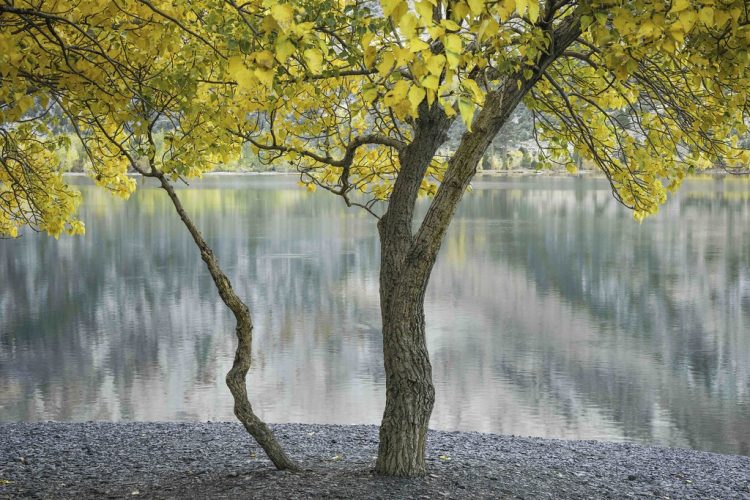QEW: A Nature Walk for All Friends
Os Cresson
One day in 1652 George Fox was concerned to demonstrate his unity with all creation. As he later described it in his journal, “[T]here came John Story to me, and lighted his pipe of tobacco, and, said he, ‘Will you take a pipe of tobacco,’ saying, ‘Come, all is ours’; and I looked upon him to be a forward, bold lad. Tobacco I did not take, but it came into my mind that the lad might think I had not unity with the creation, for I saw he had a flashy, empty notion of religion; so I took his pipe and put it to my mouth and gave it to him again to stop him lest his rude tongue should say I had not unity with the creation.” They may have been referring to a well-known Ranter saying, “If God be all things,… then he is this Dog, this Tobacco-pipe, he is me and I am him.” [1]
Nature mysticism is a broad path that was taken by many in the time of Fox. Rufus Jones had a life-long interest in this phenomenon. He wrote, “There was… a strong wave of pantheistical sentiment abroad, both on the Continent and in England…. The widespread pantheistic-mystical sects of the fourteenth century were never exterminated; they were rather driven down out of sight and became a submerged stream of influence. There were pretty plain up-wellings of this stream during the Reformation period in Europe in the sixteenth century, and… it revived in England a century later.” [2]
In 1650 Jacob Bauthumley (pronounced Bottomley) published a pamphlet containing this passage: “I see that God is in all Creatures, Man and Beast, Fish and Fowle, and every green thing, from the highest Cedar to the Ivey on the wall; and that God is the life and being of them all, and that God doth really dwell, and if you will personally; if he may admit so low an expression in them all, and hath his Being no where else out of the Creatures.” Bauthumley was severely punished for his vision of the unity of God, humankind and the rest of creation. George Fox visited him in jail in 1650 and, in return, Bauthumley visited Fox in jail in 1655. Later in life Bauthumley was described as a Quaker librarian in Leicester. [3]
Gerrard Winstanley, leader of the Digger community who became a Quaker, wrote in 1652, “To know the secrets of nature is to know the works of God; and to know the works of God within the creation is to know God himself, for God dwells in every visible work or body.” This recalls a line by Jacob Boehme, “(W)e show you the Manifestation of the Deity through Nature.” In the next century Quaker botanist John Bartram wrote, “My head runs all upon the works of God in nature. It is through that telescope I see God in his glory.” [4]
Baruch Spinoza in Holland was also uniting God and nature: “I could not separate God from Nature, as all of whom I have any knowledge have done.” In his Ethics he mentioned “God or Nature” four times. Here is an example: “Nature does not act with an end in view; that eternal and infinite being we call God, or Nature, acts from the same necessity from which he exists.” It is said Spinoza knew Quakers in Amsterdam and translated one of Margaret Fell’s pamphlets from English to Hebrew. His friend and colleague, Peter Balling, wrote Light on the Candlestick in 1662 which represented Quaker views so well that they adopted it as their own. On July 24, 1678, the scientist Robert Hooke wrote in his diary, “Much discourse about Spinosa quakers.” [5]
As Friends were first gathering, experimental scientists were also gathering. In 1660 they started meeting as The Royal Society of London for Improving Natural Knowledge. Founding members included relatives of Quakers Thomas Lower (Fox’s son-in-law) and Anne Conway (a noted philosopher and friend of Fox). William Penn was a member and called on Friends to study nature: “The world is certainly a great and stately volume of natural things; and may be not improperly styled the hieroglyphics of a better: but alas! How very few leaves of it do we seriously turn over! This ought to be the subject of the education of our youth… It were happy if we studied Nature more in natural things; and acted according to Nature; whose rules are few, plain and most reasonable. Let us begin where she begins, go her pace, and close always where she ends, and we cannot miss of being good Naturalists.” [6]
Penn gave his views on science in a letter in 1683: “I value my selfe much upon ye good opinion of those ingeneous Gentlemen I know of ye Royall Society, and their kind wishes for me and my poor Province: all I can say is that I and It are votarys to ye prosperity of their harmless and usefull Inquierys. It is even one step to Heaven to returne to nature, and though I love that proportion should be observed in all things, yett a naturall Knowledge, or ye Science of things from Sence and a carefull observation and argumentation thereon, reinstates men, and gives them some possession of themselves again; a thing they have long wanted by an ill tradition, too closely followed and ye foolish Credulity so Incident to men. I am a Greshamist throughout;” (The Royal Society met in Gresham College). [7]
In QEW there are many Friends for whom science, religion and nature come together in a splendid package. Their vision is probably as old as humans. As Daniel A. Seeger, past director of Pendle Hill, recently wrote, “Both science and religion rest ultimately on our contemplation of the natural world…. To survey any beautiful scene without distraction is to become aware of an incredible creative process that has raised all things up from the formless dust, that infuses everything with vitality and energy, that maintains balance and lawfulness, and that illuminates each order of living things with a degree of wisdom suitable to its estate. We become aware that human existence is a part of this great web, we are humbled, and we ask what response is called for from us so that we might play our role properly in this great unfolding drama. Some religionists disparage what they call nature mysticism as a counterfeit spirituality. In truth, it is not a counterfeit spirituality but the foundation, the essence, and the core of the religious sensibility.” [8]
QEW is on a path that started with the birth of our Society. It is a broad path open to Friends of all varieties: scientists and nonscientists, theists and nontheists, Christians and nonChristians, and so on. Let us all join in loving each other and loving the rest of nature.
NOTES ON SOURCES
NOTE 1: (a) George Fox, John L. Nickalls, ed. (1694/1985) The Journal of George Fox, revised edition. Philadelphia: Religious Society of Friends, p. 110; quoted in Geoffrey F. Nuttall (1947) “‘Unity with the Creation’: George Fox and the Hermetic Philosophy,” Friends Quarterly, January, 134-143. (b) Edward Hyde (1651) A Wonder and yet no Wonder…, London, p. 24; quoted in Norman Cohn (1957/1970) The Pursuit of the Millennium: Revolutionary Millenarians and Mystical Anarchists of the Middle Ages. NY: Oxford University Press, p. 291.
NOTE 2: (a) Rufus M. Jones (1932/1965) Mysticism and Democracy in the English Commonwealth. NY: Octagon Books. (b) Rufus Jones wrote about the nature mysticism of the times in two other books: (1909/1970) Studies in Mystical Religion. NY: Russell & Russell; and (1914/1971) Spiritual Reformers in the 16h and 17th Century. Gloucester MA: Peter Smith. (c) For more on the 17th century vision of the unity of all created things, see Christopher Hill (1972) The World Turned Upside Down: Radical Ideas During the English Revolution. NY: Viking Press, p. 165.
NOTE 3: (a) Jacob Bauthumley (1650) The Light and Dark Sides of God. London: William Learner; quoted in Nigel Smith (1983) A Collection of Ranter Writings from the 17th Century. London: Junction Books, p. 232. (b) George Fox (1694/1985) Journal, p. 182. (c) Norman Cohn (1957/1970), p. 303; and John N. King (2006). Foxe’s Book of Martyrs and Early Modern Print Culture, NY: Cambridge University Press, p. 156.
NOTE 4: (a) Gerrard Winstanley (1652) The Law of Freedom in a Platform, or True Magistracey Restored, in Thomas N. Corns, Ann Hughes & David Lowenstein (2009) The Complete Works of Gerrard Winstanley (2 vol.). Oxford: Oxford University Press, vol. 1, pp. 101-471. For more on the Diggers and their relation to Quakers, see David Boulton (1999) Gerrard Winstanley and the Republic of Heaven. Dent, Cumbria, UK: Dales Historical Monographs; and David Boulton (2005) “Militant Seedbeds of Early Quakerism” at www. universalistfriends.org, the website of the Quaker Universalist Fellowship. (b) Jacob Boehme (1621/1651) Signatura-Rerum p. 17; reprinted as The Signature of All Things and Other Writings, Cambridge: James Clark. (c) John Bartram, letter to Peter Collinson, Dec. 3, 1762; in William Darlington & Peter Collinson, eds. (1849/1967) Memorials of John Bartram and Humphrey Marshall. NY: Hafner
NOTE 5: (a) Baruch Spinoza (1662) Letter to Henry Oldenburg (Secretary of the Royal Society of London) in Lewis S. Feuer (1958/1987) Spinoza and the Rise of Liberalism. New Brunswick NJ: Transaction, pp. 54-55. (b) Baruch Spinoza, Edwin Curley, tr., (1985) Ethics, Princeton NJ: Princeton University Press, Part IV, Preface. (c) Richard H. Popkin & Michael A. Signer (1987) Spinoza’s Earliest Publication? The Hebrew Translation of Margaret Fell’s “A Loving Salutation…,” Wolfeboro NH: Van Gorcum, p. 7; also see Henry J. Cadbury (1941) “Spinoza and a Quaker Document of 1657,” Mediaeval and Renaissance Studies, Warbur Institute, London, vol. I, pp. 130-2. (d) In 1722 William Sewell included Light upon the Candlestick as an appendix to The History of the Rise, Increase, and Progress of the Christian People called Quakers. See Peter Balling (Rufus Jones, Sally Rickerman & Kingdon Swayne, eds.) (1662/1992) Light upon the Candlestick, Quaker Universalist Fellowship, pp. 129, 12-13, and 131-2; online at www.universalistfriends.org/candle.html (e) Henry W. Robinson and Walter Adams, eds. (1935) The Diary of ROBERT HOOKE, M.A. M.D. F.R.S., 1672-1680. London: Taylor & Francis, p. 368; quoted in Lewis S. Feuer, op. cit., p. 55.
NOTE 6: William Penn (1682) Some Fruits of Solitude, in Reflections and Maxims, quoted in Bernard Canter ed. (1952) The Quaker Bedside Book, New York: D. McKay, p. 131.
NOTE 7: Letter to John Aubrey, June 13, 1683, in William Penn (1981-7) The Papers of William Penn (ed. R. S. Dunn & M. M. Dunn), Philadelphia: University of Pennsylvania Press, vol. ii, pp. 394-396.
NOTE 8: Daniel A. Seeger (2010) “Why Do the Unbelievers Rage? The New Atheists and the Universality of the Light.” Friends Journal, 56 (January): 6-11.

